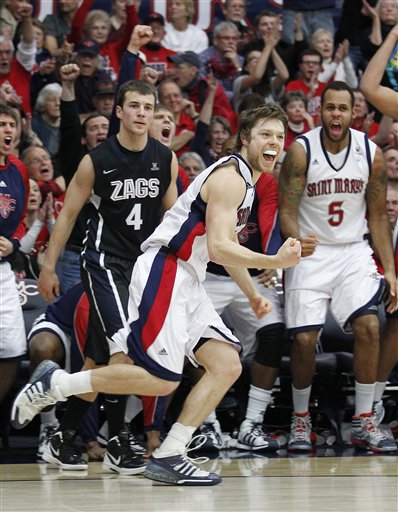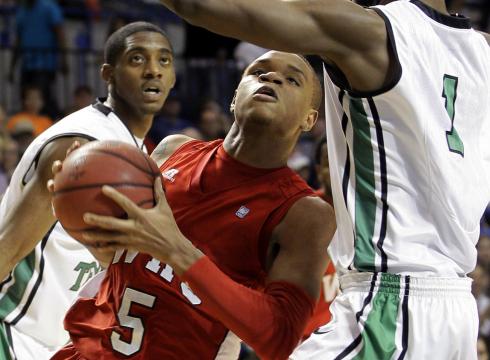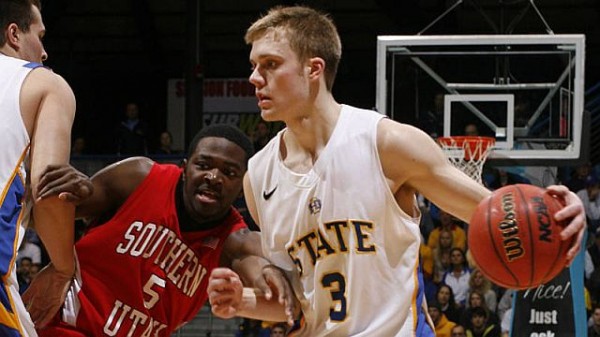Bracket Prep: St. Mary’s, Western Kentucky, Detroit, and South Dakota State
Posted by EJacoby on March 7th, 2012As we move through Championship Week (the second half of Championship Fortnight, of course), we’ll continue to bring you these short reviews of each of the automatic qualifiers to help you fill out your bracket next week. In this post, we’ve got the WCC, Summit, Horizon, and Sun Belt winners from the past two nights…
St. Mary’s
- WCC Champion (27-5, 16-2)
- RPI/Pomeroy/Sagarin = #25/#43/#35
- Adjusted Scoring Margin = +11.3
- Likely NCAA Seed: #6-#8
Three Bruce Pearls of Wisdom.
- St. Mary’s has been a nationally-recognized mid-major for a number of years now, but the Gaels program did something this year that it had never done before, and especially not in the Mark Few/Gonzaga era — win both the outright regular season WCC title and the conference tournament championship. Whether this is a notable achievement en route to a nice run in the NCAA Tournament or something that represents the highlight of the season remains to be seen, but there’s no question that this group has the team chemistry, coaching, and talent to do some damage in the coming week. Two years ago, the Gaels rode a red-hot Omar Samhan past two perimeter-oriented teams into the Sweet Sixteen, and if the matchups break favorably for them again, Randy Bennett‘s team certainly has the capability of breaking through again.
- The straw that stirs the Gaels’ drink is WCC Player of the Year, Matthew Dellavedova. The sneaky-quick Australian point guard can score (15.6 PPG), shoot (59 threes, 36.0% 3FG), dish (6.4 APG) and board (3.3 RPG), but more than any of that, it is his ability to successfully run Bennett’s offensive sets that makes him invaluable. St. Mary’s has an elite offense (#20 nationally), which is roughly on par with the Sweet Sixteen team of two seasons ago. Where it struggles, of course, is on the defensive end. As exhibited on nights against athletic teams when the shots aren’t falling, the Gaels have trouble keeping the game close enough to grind out a victory.
- As good as Dellavedova and his senior compatriot Rob Jones are (14.8 PPG, 10.7 RPG), the duo struggles against superior athletes. Jones was harassed into a rough outing against the waves of rangy athletes that Murray State threw at the Gaels in their Bracketbuster game last month, while Dellavedova was bumped into a 3-10 shooting performance (1-8 from three) against Baylor earlier in the season. This is why matchups are absolutely key for St. Mary’s next week. If they come up against a first game opponent that can out-run and out-jump them at most positions, they’re probably in big trouble — Connecticut or Mississippi State comes to mind — but if they instead find themselves matched up against a team that plays under the rim like they do — say, Harvard or Purdue — they have a great shot to advance one or two rounds.
Western Kentucky
- Sun Belt Champion (15-18, 11-9)
- RPI/Pomeroy/Sagarin = #193/#192/#203
- Adjusted Scoring Margin = -2.4
- Likely NCAA Seed: #16 (First Four)
Three Bruce Pearls of Wisdom.
- Easily the most surprising entry into the NCAA Tournament field thus far, the Hilltoppers are the sixth team in the past decade to earn a berth with a sub-.500 record. Western Kentucky was 5-14 at one point this season and decided to fire its head coach, bringing in interim assistant Ray Harper. The interim tag has since been removed, as WKU finished 10-4 under Harper including a crazy run through the Sun Belt Tournament that has the Hilltoppers dancing. They trailed by double-digits in both the semis and finals in the tourney, but this resilient team would not quit and now will find itself battling in next week’s First Four matchups. Western Kentucky has had recent success in the NCAA Tourney including a Sweet Sixteen run in 2008 and another first-round win in 2009. However, those teams had far more talent and better seeds.
- Derrick Gordon is a legitimate talent as a freshman guard who was a top-100 recruit and now leads this team in scoring (11.8 PPG). The 6’3” guard also leads the team in rebounding at 6.7 per game. In the tournament final, Teeng Akol and George Fant each had big games with 23 and 17 points, respectively. Akol is a former Oklahoma State transfer and Fant is another talented freshman. There are actually more weapons on this team than you would think for a 15-18 team, but they never put it all together until the last few games.
- Western Kentucky struggled all year long offensively, finishing with a 94.9 offensive efficiency that ranked #290 in the country. The Hilltoppers shoot it really poorly at 39.7% and average over 15 turnovers per game, a very bad combination. The youth on this team is a catalyst of poor play, given that the team’s two best players are rookies and their head coach was fired in mid-season. They proved to be a resilient squad that came back from multiple double-digit deficits in the Sun Belt Tournament, but they’d have virtually no chance to repeat that against a #1 seed. WKU is expected to head for the First Four, so it must take down another #16 seed in order to get a chance to advance.
Detroit Titans
- Horizon League Champion (22-13, 14-7)
- RPI/Pomeroy/Sagarin = #128/#115/#119
- Adjusted Scoring Margin = +2.1
- Likely NCAA Seed: #14-#15
Three Bruce Pearls of Wisdom.
- Detroit was picked to finish second in the Horizon League this year, selected narrowly behind two-time defending national runner-up Butler. With three players on the preseason All-Horizon First Team, the Titans had the talent to do big things this year. Head coach Ray McCallum’s son, Ray Jr., is a former McDonald’s All-American. Things didn’t go as planned for Detroit for much of this season, but the past eight weeks have proven how talented this team is. The Titans finished 13-2, including a dominant run through the Horizon League Tournament capped off by a 20-point victory over #1 seed Valparaiso on its home floor.
- Ray McCallum is a top guard at the mid-major level. The sophomore averages 15.6 points, 4.5 rebounds, 3.9 assists, and 1.5 steals per game as an explosive athlete with plus-skills on both ends. He’s not an experienced scorer or leader, but this team has other pieces to fill those roles. Chase Simon is a bigger guard and the senior leader averages 13.5 points per game, while senior Eli Holman, a former Indiana transfer, is a solid big off the bench (10.9 PPG, 6.8 RPG). Detroit proved it was the most talented team in the conference, and it’s no fluke.
- Detroit plays an aggressive style on both ends of the floor. The Titans’ 108.0 season-long offensive efficiency was the tops in their conference and in the top-55 nationally. They had a top-30 free throw rate and played at an above average pace speed. Their steal percentage (11.2%) and block percentage (8.7%) both ranked in the top 70 in the country, again proving the attacking mentality of the game plan. However, this team does not shoot well from deep (30.2% from three) and is just average in terms of defensive efficiency. The Titans were more athletic than their conference foes but obviously won’t have that luxury against a top NCAA Tournament seed. They will have to play smarter and hit more outside shots in order to have a chance at pulling a #14-#3 kind of upset.
South Dakota State
- Summit League Champion (26-7, 18-3)
- RPI/Pomeroy/Sagarin = #49/#55/#61
- Adjusted Scoring Margin = +8.4
- Likely NCAA Seed: #13-#14
Three Bruce Pearls of Wisdom.
- When fans heard SDSU this season, they were probably thinking about Steve Fisher’s San Diego State Aztecs. But the ‘other’ SDSU, South Dakota State, is a solid team that’s surely deserving of the NCAA Tournament berth it earned last night. The Jackrabbits are only five years into Division I existence and played second fiddle to Oral Roberts in their own conference this year, but they had a special season in their own right including a 14-0 home record that led to a top-50 RPI. Don’t be fooled by the 52-50 final in the Summit League finals; this team can put points on the board and pressure on defenses with strong outside shooters.
- Nate Wolters is a name you’ve probably heard by now. The big junior guard does it all for the Jackrabbits, leading the team in scoring (21.3 PPG), rebounding (5.2 RPG), assists (6.0 APG), and steals (1.7 SPG). South Dakota State surrounds its star with a bevy of strong outside shooters. Fellow starters Griffan Callahan, Jordan Dykstra, and Brayden Carlson all convert at least 40% from three-point range and shoot at least three per game. The Jackrabbits killed Summit League opponents with their floor spacing, led by Wolters’ ability to break down defenders off the dribble and make plays for himself or teammates.
- South Dakota State has a top-50 RPI and yet never played a single top-50 RPI opponent all season. Something doesn’t seem right there, but its Pomeroy, Sagarin, and other advanced metrics also measure this team as an efficient squad. The Jackrabbits won by 20 at Washington in December and will be taken seriously by the high-major squad it draws in round one. South Dakota State’s season-long offensive efficiency of 115.5 ranked #7 in the entire country and they turn it over just 10.5 times per game, one of the best in the nation at protecting the ball. Things will be much tougher against an athletic defensive team, but the Jackrabbits will pose problems in round one with their balanced offensive attack.














































